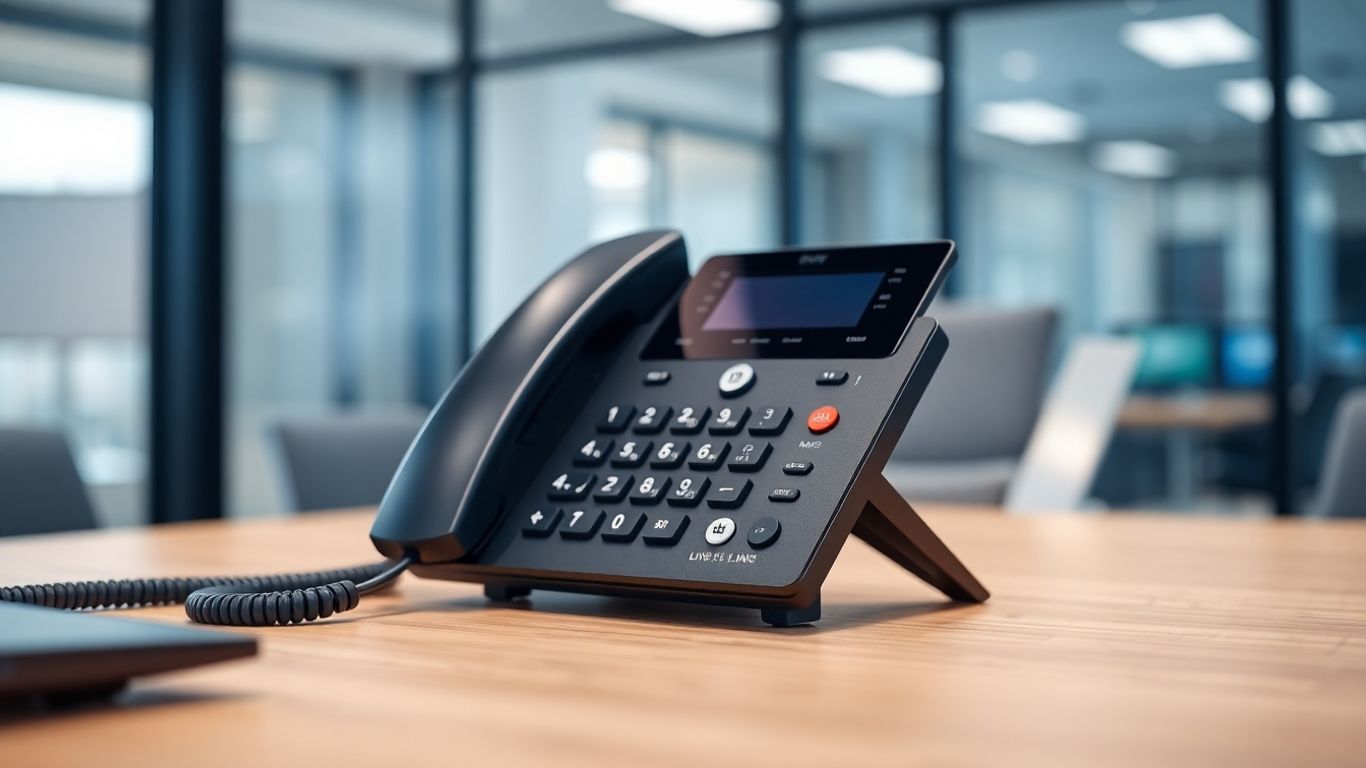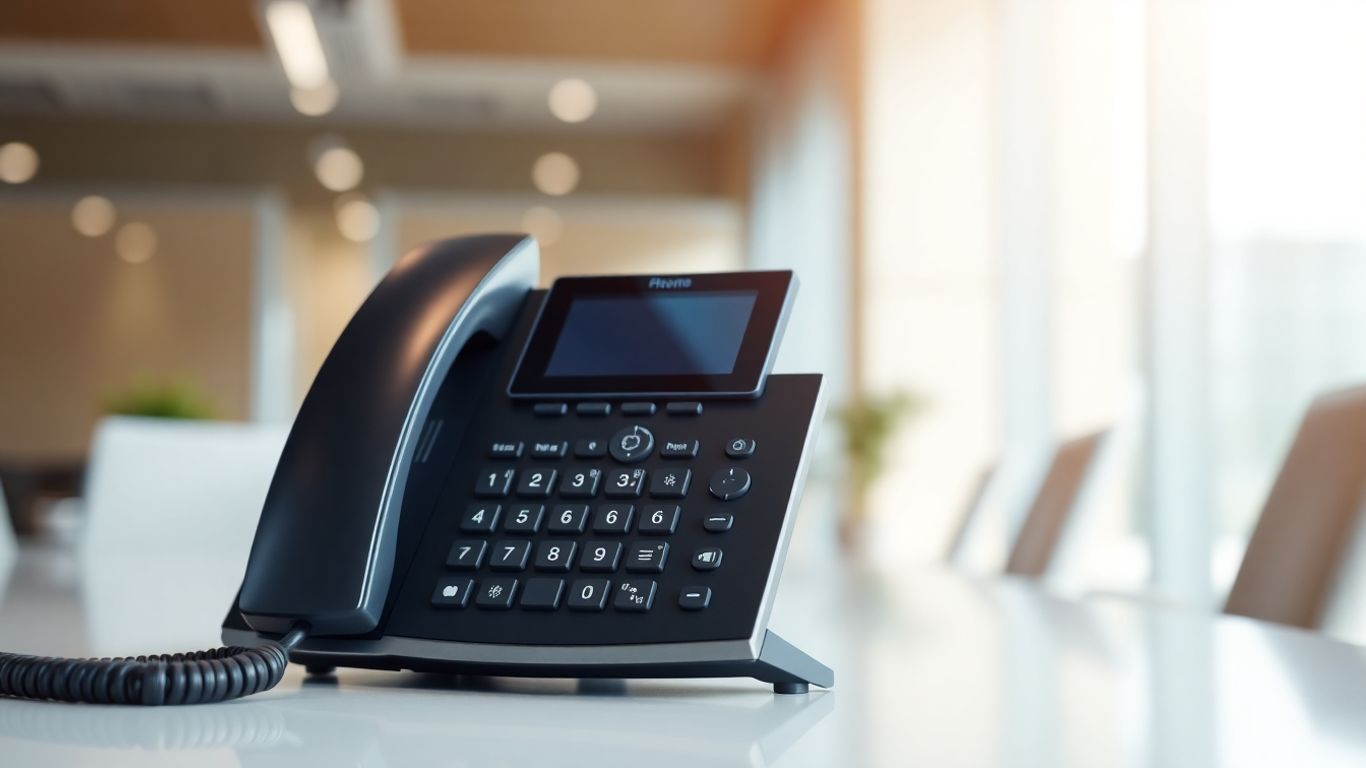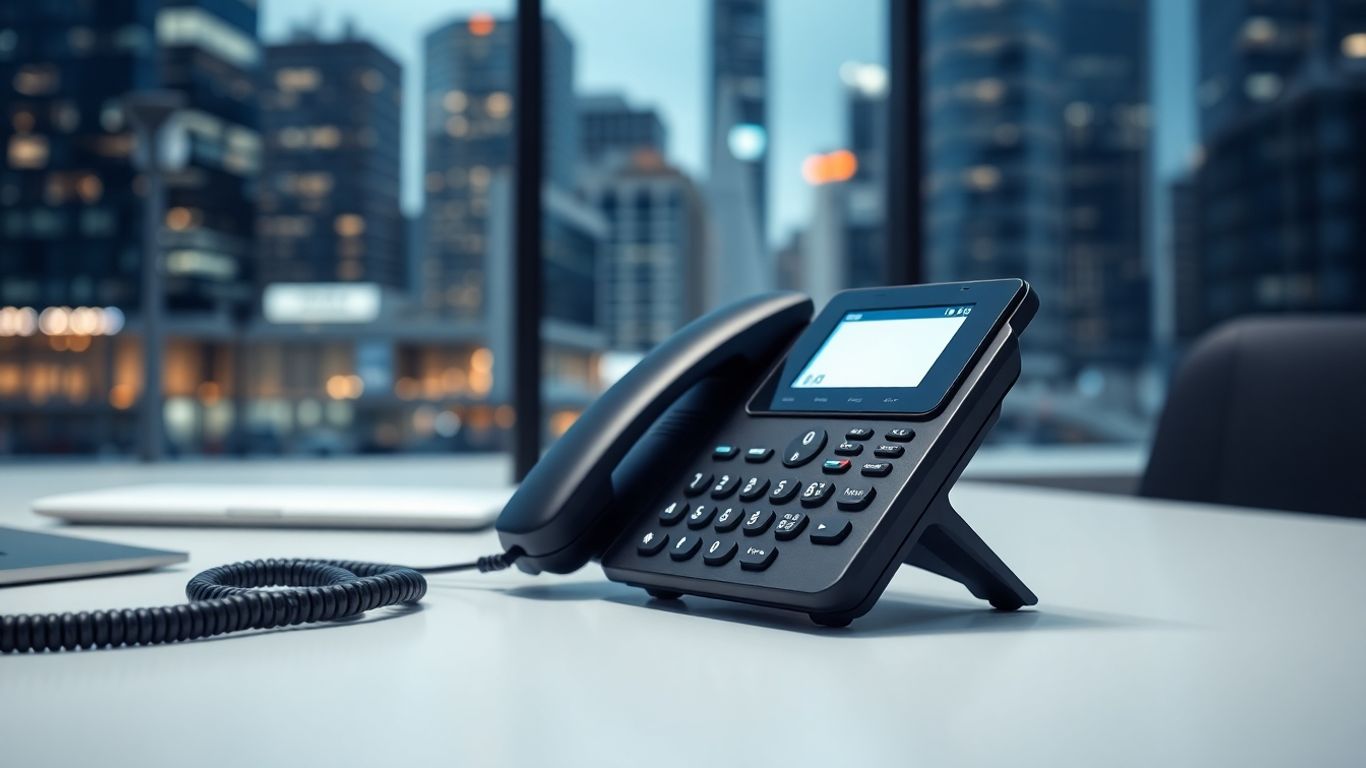Running a business means a lot of moving parts, and sometimes the phone ringing can feel like just another thing to juggle. But what if it didn't have to be? Getting a good 2 line phone system with auto attendant can seriously change how you handle calls. It's like having an extra helper, one that works around the clock. We're looking at some of the top systems out there for 2025 that can help make your business run smoother, so you can focus on what really matters.

Nextiva is a pretty solid choice if you're looking for a phone system that does more than just calls. It bundles a lot of features into one place, which can be really convenient. You get business phone, texting, and even team chat all in their desktop app. Plus, they throw in customer experience tools, which is a nice bonus.
What's cool is that Nextiva includes things like contact list management and a calendar system right in the app. You can also do VoIP calling, video conferencing, and send SMS texts. They offer unlimited calling to the US and Canada, which is great for businesses that do a lot of that kind of communication. For auto attendants, their higher-tier plans offer multi-level options and even skills-based routing. This means if someone calls, the system can try to send them to the agent best equipped to help, using data from your CRM. They also let you manage social media messages and online reviews right from the same app, which is pretty unique.
Here's a quick look at what you get:
However, Nextiva isn't the cheapest option out there. Some of their plans can get a bit pricey compared to competitors. Also, while the digital messaging channels are a unique selling point, they might not be necessary for every business. And if you're on a lower-tier plan, you might find there are limits on SMS texting.
While Nextiva offers a lot of features in one package, it's worth checking if you'll actually use all of them. If you just need a basic phone system with an auto attendant, there might be simpler, more affordable solutions. But if you want a unified platform for communication and customer interaction, Nextiva is definitely worth a look.

Quo, which used to be called OpenPhone, is a pretty straightforward phone system that’s good for businesses that need to handle calls and texts efficiently. It’s not flashy with video calls or team chat, but it really shines when it comes to sharing phone numbers. Imagine your whole team being able to use the same business number to make calls and send texts – Quo makes that happen. This is a big deal for keeping your customer-facing number consistent, even if different people are handling the calls.
They’ve also jumped on the AI train, which is neat. You get things like call summaries that actually tell you what happened in a conversation and suggested replies for texts. We found these AI bits to be pretty reliable and genuinely helpful, not just some gimmick. Plus, if your team juggles a lot of different numbers or needs to jump between them quickly, Quo makes that super easy with just a click.
Here’s a quick look at what they offer:
One thing to note is that Quo doesn't offer any hardware phones. You'll be using their app on your computer or mobile device. Also, if you're big on deep analytics to track every single call metric, Quo might feel a bit light in that department compared to some other options out there.
Quo has a couple of pricing tiers, with the Starter plan at $15 per user per month and the Business plan at $23 per user per month. The Business plan is where you really get the full suite, including those AI features and more advanced call routing options like custom ring orders. If your team needs that flexibility and collaboration around phone numbers, it’s definitely worth considering.
My AI Front Desk is pretty neat if you're looking for a virtual receptionist that really feels like a human. It's designed to handle a lot of the day-to-day stuff that eats up your time, like answering common questions and even scheduling appointments. This service aims to make your business look more professional and run smoother, especially if you're a small operation that can't afford a full-time receptionist.
It's super fast, responding in milliseconds, which means it can keep up with natural conversation without that awkward pause you get with some automated systems. Plus, it integrates with over 9,000 apps through Zapier, which is pretty wild. This means it can update your CRM, create tasks, or notify your team automatically after a call. It's like having a digital assistant that talks to all your other business tools.
Here's a quick look at what it can do:
The system is built to be incredibly scalable. Imagine your business suddenly gets a huge influx of calls – maybe because of a viral social media post or a big sale. Instead of getting overwhelmed and missing opportunities, this AI receptionist can handle all those calls simultaneously without breaking a sweat. It keeps your customer service consistent, no matter how busy things get.
They also have a free 7-day trial, so you can test it out before committing. It's a good way to see if it fits your workflow and if your customers find it helpful. You can check out their AI-powered phone agent to see how it automates outbound calls, which is another way they're using AI to help businesses.
RingCentral is a pretty solid choice if you're looking for a two-line phone system with an auto-attendant, especially if your team also needs tools for chatting and video calls. They've really packed a lot into their platform.
One of the standout features is their IVR studio. It's got this drag-and-drop interface that makes building out your call flow, like what happens when someone calls, surprisingly easy. You can set up multiple levels for your auto-attendant, create different call queues, and route calls to specific teams or people. This means you can build a pretty sophisticated system without needing to be a tech wizard. Plus, they offer international phone numbers, which is handy if you have customers all over the globe and want your caller ID to look local.
Here's a quick look at what you get with their plans:
While RingCentral offers a lot, it does come at a higher price point compared to some other options. You're paying for that extensive feature set, especially the collaboration tools. If you just need a basic auto-attendant, you might find cheaper alternatives. But if you want a system that does more than just answer phones, RingCentral is definitely worth a look.
Their pricing starts around $30 per user per month when billed annually, which puts it on the pricier side. However, for that cost, you're getting a robust system that can handle complex call routing and also supports team communication. It's a good fit for businesses that want to consolidate their communication tools into one platform.

Vonage offers a business communication platform that bundles voice, video, and text features. It's designed to be flexible, allowing you to mix and match core functionalities with add-ons to suit your specific needs. For businesses looking for a polished caller experience and CRM integrations without going full enterprise, Vonage's Premium tier can be a good middle ground. They also provide a wide array of virtual numbers, including plenty of toll-free and local options across North America and internationally.
When it comes to the auto-attendant feature, Vonage offers multi-level options, but these are typically found on their Premium plan or higher. This means you'll need to step up from the most basic package to get that more sophisticated caller routing. While these systems allow you to direct calls to employees or departments based on business hours, some advanced features like call recording are often an extra cost, which can add up. It's worth noting that Vonage's auto-attendant functionality isn't available in all regions, so be sure to check if it works for your specific locations, like the UK or Australia.
Here's a look at their plan structure:
While Vonage provides unlimited SMS within the US and Canada, which is a big plus for many businesses, some of their more desirable features, like a shared messaging inbox, are also considered add-ons. They do offer unlimited calls and team messaging across desktop, web, and mobile apps, which is handy for keeping everyone connected.
Vonage's strength lies in its API capabilities and customization options, making it a solid choice if you need to integrate your phone system deeply with other business tools. However, be prepared to potentially pay extra for features that are standard with some competitors.

Grasshopper is a virtual phone system that really focuses on keeping things simple, which is pretty nice if you're not looking for a ton of complicated features. It works by using your existing phone network, so it's not exactly a true VoIP system in the way some others are. Instead, it forwards calls to your current number. This makes it super easy to get started, especially for solopreneurs or really small teams who just need the basics.
One of the standout things about Grasshopper is its pricing. Instead of charging per user, they charge per account. This can be a real money-saver if you have a small team where multiple people might share an extension or if you don't need everyone to have their own dedicated line. It's definitely geared towards businesses that want a straightforward way to handle calls and texts without a lot of extra bells and whistles.
When it comes to the auto-attendant part, Grasshopper has a basic setup. You can record your own custom greeting, or you can even pay a one-time fee to have a professional record it for you. Plus, you can set custom business hours, so callers get sent to voicemail when you're closed. They also have a neat feature for controlling incoming calls, letting you screen caller IDs and block spam before it even rings.
However, it's not all sunshine and rainbows. Because it's account-based pricing, if you need each person on your team to have their own unique phone number or extension, you might find other services are more affordable. Also, if you're looking for advanced routing features like call queues or complex IVR menus, Grasshopper feels a bit limited. And just so you know, they don't support desk phones; it's all done through their desktop and mobile apps.
Here's a quick look at their plans:
Grasshopper is a solid choice if your main goal is a no-fuss virtual phone number with reliable calling and texting capabilities. It's particularly good for those who value simplicity and a unique pricing model that can benefit smaller, shared-use teams. Just be aware of its limitations if you need more advanced call management or individual lines for everyone.
When you're looking at phone systems, 8x8 pops up as a pretty solid contender, especially if your business has a global reach. What really sets them apart is their international calling. Unlike most other services that limit unlimited calling to just the US and Canada, 8x8 throws in 14 countries, including places like the UK, India, and Australia, all on their basic plans. This can be a huge cost saver if you're regularly making calls to these regions or if clients from these countries often reach out to you.
Their auto attendant setup uses a drag-and-drop builder, which is pretty standard these days. It lets you map out call flows, set up ring groups, and create IVR menus. While the interface might feel a bit plain compared to some flashier options, it's functional and gets the job done without too much fuss. They also offer a dedicated app for receptionists called 8x8 Frontdesk, which is designed to help manage high call volumes with features like quick transfers and an accessible contact directory.
Here's a quick look at some of their features:
One thing to keep in mind is that while 8x8 offers a lot, some of their more advanced features, like detailed call analytics or supervisor tools like call monitoring (listen, whisper, barge), are usually tied to their higher-tier plans. So, if you need those, be prepared for a bigger investment. Also, their monthly SMS limit per user is quite low, just 25 messages, which might be a bottleneck for businesses that rely heavily on text communication.
For companies that need to connect internationally without breaking the bank, 8x8 is definitely worth a closer look. It provides a good balance of features for businesses that are growing and might have a global footprint. You can explore their unified communications options to see if it fits your needs.
Phone.com offers a virtual phone system that can work for businesses of all sizes, from small startups to larger companies. Instead of a fixed plan, they charge per user, which means your total cost depends on the features and permissions you give each person on your team. You can mix and match these user types to fit what your business actually needs.
While Phone.com doesn't explicitly advertise an "auto-attendant" feature like some others, they do provide phone menus, call queues, and a dial-by-name directory. This setup lets you route incoming calls to the right department or person. They also have a neat feature called "voice tagging" which lets your team know which extension a caller selected, so they can greet them properly, like "Thanks for calling Billing, how can I help you?" It's a nice touch for customer service.
When it comes to team collaboration and features like call recording, you might find yourself paying extra. Basic and Plus plans require an additional $8 per month for call recording, which gives your team more context on customer interactions. If you want a shared number for your team, that's another $5 per month. They do offer a live receptionist service, but it's quite pricey at $90 per month, no matter your plan.
One thing to watch out for is that the most basic plan only includes one phone number per account and has limits on monthly call minutes and text messages. You'll need to upgrade if you plan on heavy usage or need more numbers.
Here's a quick look at their user plans:
Phone.com's per-user pricing model can be flexible, allowing you to tailor costs to your team's specific roles and needs. However, be mindful of the limitations on lower-tier plans, especially regarding call minutes and the need for add-ons for features like call recording.
Google Voice is a pretty interesting option, especially if your business is already deep into the Google ecosystem. It's not exactly a free-for-all for business use, though; you'll need to pay for a business plan and a Google Workspace subscription to get the good stuff, like the auto-attendant.
What you get with the paid plans is pretty decent. You can set up custom greetings, route calls, and even set your business hours so callers know when to expect a human. The auto-attendant feature lets you create multi-level menus, which is handy for directing people to the right department or just sending them straight to voicemail if needed. Plus, you can set it up for holidays and after hours.
Here's a quick look at the business plans:
Remember, you'll also need to add about $6 per user per month for Google Workspace itself. So, it adds up, but it's still pretty competitive.
One of the big pluses is security. Google Voice has some really strong security features, like multi-factor authentication and encryption, which is great for peace of mind. If you're already using Gmail, Drive, and Calendar for work, the integration is super smooth. It just works with what you've got.
However, if your business relies on a lot of different software that isn't made by Google, you might run into some limitations. Google Voice doesn't play nicely with non-Google apps, which is a bit of a bummer compared to some other systems out there.
Also, keep in mind that text messaging is only available for users in the US. So, if you're an international business, that might be a dealbreaker. Overall, for Google-centric businesses looking for a solid, secure, and integrated phone system with an auto-attendant, Google Voice is definitely worth a look.
Talkdesk really stands out because it's not just a phone system; it's a full-blown contact center. This means you can handle customer interactions not only through calls but also via SMS, social media, live chat, and email. It's designed to manage all these channels from one place, which is pretty neat.
The drag-and-drop builder makes setting up your auto attendant or even live chatbots surprisingly straightforward. You can create complex call routing systems with ring groups and call queues, all visually mapped out. It also has a cool feature that lets you embed surveys directly into your auto attendant flows, giving you a way to gather customer feedback right after an interaction.
Here's a quick look at some of its capabilities:
Because Talkdesk is a comprehensive contact center solution, it comes with a higher price tag. It's a fantastic option if you need to manage a lot of different communication channels and want advanced features. However, if you're just looking for a basic auto attendant for your phone lines, it might be more than you need.
Talkdesk starts at around $85 per user per month. While it offers a lot, including over 70 integrations with other business tools like CRMs, it's definitely on the pricier side compared to simpler phone systems. It's best suited for businesses that are serious about multichannel customer engagement.
Talkdesk offers a smart way to handle your calls. Imagine never missing a customer because your phone is busy. Our system answers calls 24/7, making sure every lead is captured and qualified. It's like having a super-efficient assistant who never sleeps. Ready to see how it works? Visit our website to learn more and start your free trial today!
So, there you have it. Picking the right two-line phone system with an auto-attendant in 2025 isn't just about getting a new phone number. It's about making your business run smoother, look more professional, and actually help you connect with more customers. These systems can handle a lot of the day-to-day stuff, freeing you up to focus on what really matters – growing your business. Don't overthink it; find the one that fits your needs and budget, and get ready to see the difference it makes.
Think of it like a smart receptionist for your business phone. A 2-line system lets you handle two calls at once. When someone calls, the auto-attendant, like a pre-recorded voice, greets them and offers options, such as 'Press 1 for Sales' or 'Press 2 for Support.' This helps direct callers to the right place without you needing to answer every single call yourself.
An auto-attendant makes your business look more professional and organized. It ensures callers get to the right person or department quickly, reducing wait times and frustration. Plus, it frees up your staff to focus on more important tasks instead of just answering basic questions or routing calls.
Absolutely! Most systems let you record your own greeting and set up custom menus. You can change these options whenever you need to, like updating holiday hours or announcing new services. It's all about making the system work best for your specific business needs.
Not necessarily. Many modern systems are cloud-based, meaning they work over the internet. You can often use regular desk phones, your computer, or even your smartphone with an app. This makes them flexible and easy to set up without needing a lot of new hardware.
A basic auto-attendant uses simple number presses (like 'press 1'). An advanced one might understand spoken words (voice commands) or have multiple levels of menus to guide callers even more precisely. Some even use AI to answer questions or schedule appointments automatically.
Yes, that's one of its best features! You can set up your auto-attendant to give a different greeting and options after your regular business hours. It can direct callers to leave a voicemail, provide emergency contact information, or even offer limited self-service options 24/7.
Many providers aim for simplicity. Setup often involves just a few steps online, like recording your greeting and choosing menu options. Managing them is usually done through a simple online portal or mobile app, so you can make changes anytime, anywhere.
Definitely! Small businesses can greatly benefit from the professional image and efficiency an auto-attendant provides. It helps them compete with larger companies by offering structured call handling and better customer service without the cost of a full-time receptionist.
Start your free trial for My AI Front Desk today, it takes minutes to setup!








